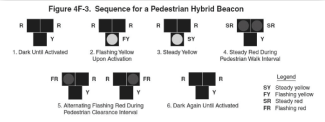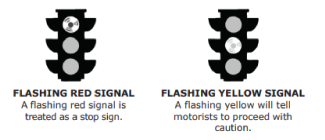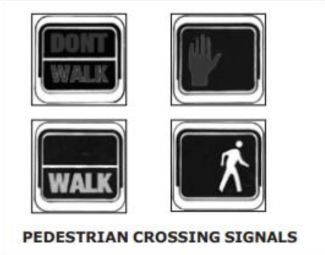Traffic Lights/Signals
Traffic signals allow vehicles to proceed safely through busy intersections. They give the right-of-way to drivers and pedestrians one street at a time. Beware that not all intersections have traffic signals or traffic control signs. Intersections without signs or signals are known as uncontrolled intersections. When approaching uncontrolled intersections, motorists must treat the intersection as if there were a yield sign present. Signaled intersections give the right-of-way to drivers and pedestrians one street at a time. When a driver fails to stop at a red light, others who have a green light should not insist on the right-of- way. Motorists should be alert for possible violators of the law and prepare to stop to avoid a collision. You should slow down, cover the brake, and proceed with caution when approaching all intersections. Covering the brake means taking your foot off the accelerator pedal and hovering it over the brake pedal without touching it, preparing to push the brake pedal if a hazard should arise. Right-of-way is the privilege of having or giving other motorists immediate use of a certain roadway.
-
Steady Red Light: Stop before reaching the crosswalk and wait until the light is green (unless another light such as a green arrow directs you otherwise).
-
Right Turn on Red: Except when a sign is placed prohibiting a right turn on red, vehicles may turn right on a steady red light after the driver has stopped completely and yielded the right-of-way to pedestrians and other vehicles. Remember: A motorist stopped at are red light does not have to turn right on red if they do not desire to do so.
- Steady Yellow Light: A yellow light tells a driver that a red light is next. Slow down and proceed with caution if a stop cannot be made safely. A motorist must proceed with caution through the yellow light so as to clear the intersection as required by law.
- Steady Green Light: You may proceed with caution to avoid colliding with another vehicle or pedestrian.
- Flashing Yellow Light: Slow down, cover the brake, then proceed with caution.
- Flashing Red Light: When nearing a flashing red traffic light, you must make a full stop and yield the right-of-way to all vehicles on your right and left. Treat the flashing red signal as a stop sign.
- Traffic Light with a Green Arrow: In cities, intersections often have traffic lights that show a green arrow along with the red light. Vehicles at the light may proceed into the intersection and turn in the direction indicated by the green arrow. This is known as a protected turn lane. A protected turn lane will protect motorists as they turn at intersections. They are protected from on-coming traffic, and a special lane with markings designates this lane. The lane will have an arrow signal, which allows safe passage.
- Traffic Light with a Red Arrow: Red arrows are usually used on left/right-hand turns. When a red arrow is displayed, you must stop and may not proceed in the direction of the arrow. When the red arrow goes out, it will be followed either by a green arrow, a steady green light, or a flashing yellow arrow. If there is a lane marked for turning, you should be in that lane well in advance of approaching the intersection, give your signal and make the turn so as not to interfere with other traffic.
- Traffic Light with a Flashing Yellow Arrow: Flashing yellow arrows are sometimes used for left-hand turns. When a flashing yellow arrow is displayed, you may proceed with turning in the direction of the arrow only after yielding to oncoming traffic and pedestrians. Oncoming traffic has a steady green light.
- Stale green light is a light that has been green for a while.
- Fresh green light is a light that has just turned green.
- HAWK: High-Intensity Activated Crosswalk is used to let pedestrians safely cross a street.
HAWK: HIGH-INTENSTY ACTIVATED CROSSWALK (check with DOT)





